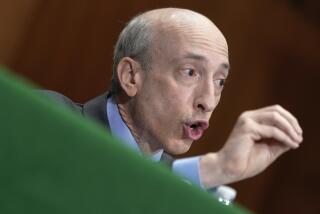Your ETF may get riskier with a planned rule to ease approvals of exchange-traded funds

- Share via
Starting an exchange-traded fund is about to get a little easier. But a quirky provision in the plan may expose investors to new risks.
More than 10 years after regulators first considered streamlining ETF approvals in the U.S., the Securities and Exchange Commission is readying a proposal that will shave months off the process and end inconsistencies that have created a lopsided playing field.
But the proposal also could make it easier for fund managers to admit substandard securities into existing ETFs for reasons that have nothing to do with what’s best for the portfolio.
Since the first ETF started trading 25 years ago, the funds have exploded into a $3.4-trillion industry of more than 80 U.S. providers. There was no ETF-specific rule when they began, so they operated under an exemption to the Investment Company Act of 1940. Little has changed since then, even as they’ve become bigger and more complex and have drifted away from mutual funds.
So adapting regulations to the new ETF industry was all but inevitable. The question is, do the benefits for issuers and investors outweigh the potential costs?
The Securities and Exchange Commission declined to comment. Dalia Blass, who leads the regulator’s investment management division, said in a speech last week that “delivering a recommendation to the Commission for a rule is a high priority for the division, and our ETF team is hard at work.”
The intention is that both issuers and investors benefit from the provision, which makes it easier for managers to choose the securities for their ETFs when they issue new shares and those they surrender when they destroy shares. While early adopters such as BlackRock Inc. and State Street Corp. already have some flexibility as to which securities they can admit or distribute, known as creating a custom basket, more recent issuers have to stick to a pro-rata slice of their portfolio.
This has put the newcomers at a disadvantage, as managers are forced to accept securities they already own or cash — both of which can hurt the end-investor if they’re traded for, or invested in, other securities.
There’s also a tax hit during redemptions. Bond funds in particular suffer under this regime as debt instruments can be hard to find and difficult to trade. These strategies house less than 20% of assets in U.S. ETFs.
“The benefit of the custom basket is the tax efficiencies it can generate,” said Stacy Fuller, a partner at K&L Gates. “The division recognizes the necessity of leveling the competitive playing field for all ETF issuers, and they’ve really educated themselves on the value of custom baskets for ETF shareholders and become less wary as a result of having undertaken that education on the potential for custom baskets to be abused.”
That wariness had governed the SEC’s thinking for years and gets to the heart of how ETFs work.
ETF issuers rely on a group of middlemen known as authorized participants to supply the baskets of securities that they then add to their funds. If these baskets were flexible, the concern is that a small ETF might be tempted to accept less-than-perfect securities from these banks and electronic traders in exchange for much-needed assets. Or an ETF could be persuaded to deliver better securities from the fund to a broker that it relies on for business. This is known as “dumping” or “cherry picking.”
“They are concerned about situations where an authorized participant exerts power over an ETF,” Jane Heinrichs, associate general counsel at the Investment Company Institute, an industry association for mutual funds and ETFs, said of the SEC. “But there are enough other belts and suspenders that take care of that. If you show favoritism to one authorized participant, it’s not going to be a long-term game.”
Bad behavior would likely increase a fund’s tracking error — the margin by which its performance diverges from that of its index — prompting investors to move their money elsewhere. And manager compensation is also often linked to how closely an ETF tracks its underlying index, discouraging abuse.
Nevertheless, the regulator could introduce measures to mitigate this unintended byproduct of reform, such as requiring ETFs to spell out their policies on flexible baskets, which the board then would approve with oversight from directors or the fund’s chief compliance officer. (Boards already act as fiduciaries and monitor each fund’s management on behalf of shareholders.)
The proposed rule likely will be released by October and the public and industry invited to give feedback. Comment periods typically last around 30 to 90 days, after which regulations are finalized and a compliance date set.
Evans writes for Bloomberg.
More to Read
Inside the business of entertainment
The Wide Shot brings you news, analysis and insights on everything from streaming wars to production — and what it all means for the future.
You may occasionally receive promotional content from the Los Angeles Times.










